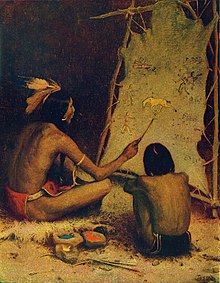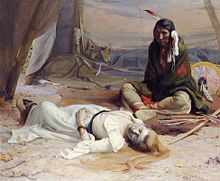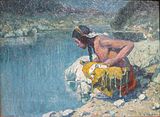Eanger Irving Couse
Eanger Irving Couse (born September 3, 1866 in Saginaw , Michigan , † April 26, 1936 in Albuquerque , New Mexico ) was an American painter and a founding member and the first president of the Taos Society of Artists . He is known for paintings depicting scenes from Native Americans , New Mexico, and the Southwestern United States . His house and studio in Taos are part of the Eanger Irving Couse House and Studio - Joseph Henry Sharp Studios and are on the National Register of Historic Places and are on the New Mexico Register of Cultural Properties .
Youth and education
Couse was born in Saginaw , Michigan . As a teenager he drew Indians of the Chippewa , whose tribe lived nearby. He attended local schools and was primarily interested in art.
Couse began professional art studies at the Art Institute of Chicago and later moved to the National Academy of Design in New York . He then went to Paris , where he received further training at the École des Beaux-Arts and the Académie Julian under William-Adolphe Bouguereau . He lived in France for 10 years and mainly painted landscapes of the Normandy coast. Between 1893 and 1896 he lived in the Etaples Art Colony , where he painted street and fisherman scenes, including the picture Coastal Scene, Etaples .
Career
After returning to the United States, Couse lived in New York. During the summer he spent time in Taos , New Mexico. At the beginning of the 19th century, many artists and writers were enthusiastic about the Southwest, and New Mexico in particular, because the desert areas remained untouched by national expansion efforts determined by the American ideology of Manifest Destiny . The artists and writers of this era strove to capture the last impressions of the "Old West" before the era completely disappeared. In New Mexico, Couse studied and painted the life and culture of the Taos Indians, a Pueblo tribe. He was able to furnish his first solo exhibition in 1891 with pictures of “Native American Life”.
In 1911, Couse was elected to the National Academy of Design and was involved in the Taos Art Colony . Couse was also one of the six founding members of the Taos Society of Artists in 1915 , and became the first elected president of the same. Another founding member was the artist John Henry Sharp , who had set up a chapel near Couse's house as a studio. Sharp later built a combined house and studio on the site. The adjoining house lots are listed as the "Couse / Sharp Historic Site" and are managed by the Couse Foundation .
Among Couse's works in public galleries are Elk-Foot of the Taos Tribe ( Smithsonian American Art Museum ); Taos Pueblo - Moonlight ( New Mexico Museum of Art ); The Forest Camp ( Brooklyn Museum of Art ); The Pottery Maker ( Two Red Roses Foundation ); The Tom-Tom Maker ( Lotos Club , New York); Medicine Fires (Montclair Gallery, New Jersey), and Shapanagons, a Chippewa Chief ( Detroit Museum of Art ).
The painting Elk-Foot of the Taos Tribe , from 1909, is considered Couses masterpiece. The painting was acquired for the United States National Art Collection by art collector William T. Evans and is now on display in the collection of the Smithsonian American Art Museum. Elk-Foot , whose Anglicised name was "Jerry Mirabal", began posing for Couse in 1907 and was one of the painter's favorite models because of his "physical beauty and ideal features".
Works
Couse's work The Captive was shown in his first solo exhibition at the Portland Art Association in Oregon in 1891 and later at the Paris Salon in 1892. This large, "salon size" painting was the first painting with a "Native American theme." In 1991, The Captive was shown again in the National Museum of American Art exhibition entitled The West as America , whereupon a controversy arose over the curators' interpretation of the artist's intention. Art historians have criticized the racial, sexual, and social motives in the context of American society at the time.
In 1899, Couse exhibited three paintings at the Boston Art Club : A Cayuse Indian (oil), Maternity (oil), and Yakima Encampment (oil). At the time, Couse gave a residential address at Van Dyck Studios, 939 8th Avenue, New York City .
More pictures
Mending the War Bonnet ; Making Pottery (won the $ 500 National Academy of Design Carnegie Prize ); Roasting corn (1904); Rushing Water (1912); Twilight, Taos Pueblo (1913); Taos Canyon Camp ; Taos Pueblo - Moonlight (1914); The Kachina Painter (1917);
Legacies and Honors
Couse's work has received awards from various institutions: the Paris Salon, the Art Institute of Chicago, the National Academy of Design (Altman Prize, 1916); and at the Salmagundi Club (Isidor Prize, 1917). He also received the Lippincott Prize of the Pennsylvania Academy of Fine Arts in 1921. And awards at the American Exposition , Buffalo ; Boston Art Club , Corcoran Gallery , and the Panama Pacific International Exposition in San Francisco (silver medal, 1915).
From 1914 his pictures were printed in the widespread Santa Fe Railroad Calendars .
His studios, which are listed as part of the Eanger Irving Couse House and Studio — Joseph Henry Sharp Studios on the National Register of Historic Places and the New Mexico Register of Cultural Properties , are among the 30 buildings listed as the Historic Artist's Home and Studio Associate Site “Maintained by the National Trust for Historic Preservation . In 2001 the Couse Foundation was created to maintain the property.
death
Couse died in Albuquerque , New Mexico in 1936 . He was buried in the Sierra View Cemetery in Taos.
Individual evidence
- ^ Pronounced to rhyme with "house" Charles Earle Funk : What's the Name, Please? . Funk & Wagnalls, 1936.
- ↑ a b Couse, E (anger) Irving (1866-) . In: New International Encyclopedia , 2nd. Edition, Volume 6, Dodd, Mead, 1914, p. 190.
- ↑ Eanger Irving Couse: Elk-Foot of the Taos Tribe . In: Smithsonian American Art Museum . Smithsonian Institution. Retrieved August 10, 2012.
- ↑ Related: Taos Pueblo - Moonlight . In: Searchable Art Museum . New Mexico Museum of Art. Archived from the original on August 9, 2014. Info: The archive link was automatically inserted and has not yet been checked. Please check the original and archive link according to the instructions and then remove this notice. Retrieved July 9, 2013.
- ↑ Virgina Couse Leavitt: Eanger Irving Couse: Image Maker for America . The Albuquerque Museum, Albuquerque, NM 1991.
- ↑ Michael K. Komanecky: Phoenix Art Museum: Collection Highlights . Harry N. Abrams, Inc., New York 2002, ISBN 978-0-8109-3245-6 , p. 60.
- ↑ The Bird Jar
- ^ The Captive (1891), Phoenix Art Museum
- ^ The Housewife Looking at the Fisherman's Catch
- ↑ In Ambush
- ↑ Love Song (aka Moonlight)
- ^ The Medicine Maker
- ^ Pottery Vendor (1916)
- ↑ The Couse-Sharp Historic Site . In: Couse-Sharp.org . Couse Foundation.
- ↑ Find a Grave : Eanger Irving Couse.
Web links
| personal data | |
|---|---|
| SURNAME | Couse, Eanger Irving |
| BRIEF DESCRIPTION | American painter |
| DATE OF BIRTH | September 3, 1866 |
| PLACE OF BIRTH | Saginaw , Michigan |
| DATE OF DEATH | April 26, 1936 |
| Place of death | Albuquerque , New Mexico |














